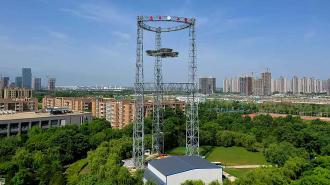Researchers at Xidian University have announced the successful test of components needed for a space-based solar power system, which aims to use satellites with a constant supply of sunshine to beam power ground arrays on Earth.
According to a Google-translated statement from the university, a number of important technologies for making space-based solar power a reality were tested and verified June 5, 2022, including those needed for efficiently translating light into electricity, converting electricity into microwaves, accurately beaming microwaves to a relay station, receiving and reconverting them into electricity, and the mechanical structure of the system.
Xidian University tested and verified a number of important technologies for making space-based solar power a reality.
The researchers say they were able to successfully transmit energy by microwaves around 180 feet — a small proof-of-concept experiment.
The space-based solar power array is a 246ft tall tower on the Xi’an, China-based university’s southern campus.
“The research on space solar power plants is currently a hot spot in the world,” Xidian’s Duan Baoyan, who launched the proposal — dubbed the Orb-Shape Membrane Energy Gathering Array, or, awesomely, OMEGA — in 2014.
Space-based solar power: Solar trailblazer and Apollo Program scientist Peter Glaser first proposed the idea of using satellites to beam solar power from space to Earth in the late 1960s.
Glaser’s idea was to gather up the solar radiation from orbit, convert it into microwave energy, then beam it back to us, Leonard David, who worked with Glaser, wrote in an obituary for Space.com.
As the Department of Energy explains, more solar energy strikes the Earth every day than humans use in a year. Roughly 30% of that gets ricocheted away from us by the atmosphere, which combines with dust, pollution, seasons, and, y’know, night to interfere with harvesting that sweet solar power.
But none of those obstacles exist in space.
A space-based solar power platform would use satellites to gather solar radiation to be beamed down to relay stations on Earth.
In theory, a space-based solar power platform would use satellites in orbit to gather solar radiation via large mirrors, which reflect the energy into solar collectors. From there, it could be beamed down to relay stations on Earth using microwaves — like Glaser envisioned — or lasers.
NASA aims to get into the game as well, with their SPS-ALPHA project initially proposed in 2012, while Japan “has come from behind and has become one of the most cutting-edge researchers in the world,” the Xidian statement said, being the first nation in the world to officially incorporate the solar plants into their space program’s vision.
In 2015, Japanese researchers also successfully wirelessly transferred energy via microwave, although Bayoan notes that this did not test each element of the entire process, like OMEGA’s array.
A long way: While an exciting proof-of-concept (and three years ahead of schedule, to boot), we’re still a long way from space-based solar power.
In addition to the technical and engineering challenges — 180 feet is a far cry from orbit — there are also safety concerns, including the high-frequency energy beam’s potential impact on people living nearby and communications and aviation systems, Interesting Engineering noted.
Even more significant is the cost per watt of energy delivered, especially compared to other increasingly cheap options, like ground-based solar arrays. It’s not clear where this kind of energy would be economically viable.
The “transmission to heaven from Earth” will require the work of future generations, Baoyan said.
We’d love to hear from you! If you have a comment about this article or if you have a tip for a future Freethink story, please email us at [email protected].






